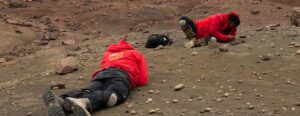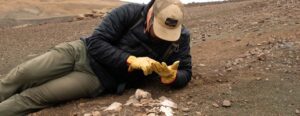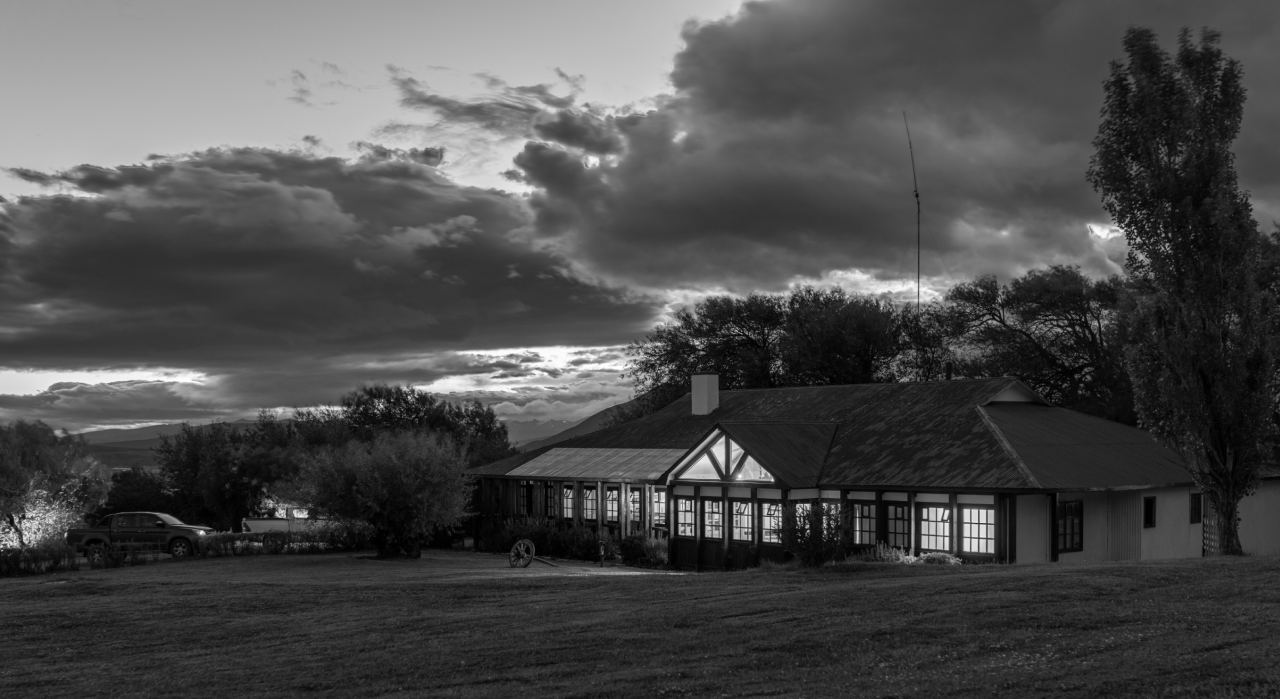05 April 2024

Las Chinas River Valley: A Gateway to the Past
What would you think if I told you that time materializes? That it comes in different colors, shapes and sizes? That we can touch it? Feel its textures and see its colors? In the Las Chinas River Valley, on the grounds of Estancia Cerro Guido, it is possible.
The Las Chinas River Valley is a unique landscape. A flow of water surrounded by imposing mountains, hills and hillsides. Earth, sand and rock masses that serve as a quilt for those who found eternal rest millions of years ago.
The Chilean National Antarctic Institute (INACH) conducts annual campaigns in the Las Chinas River Valley in February. They usually stay for about 2 weeks, divided into several camps, with each individual dedicated to his or her specialty.
The reason? The Las Chinas River Valley, located in the grounds of Estancia Cerro Guido, hides a paleontological paradise, where year after year new fossilized bones emerge, whose discoveries make paleozoology scholars question their previous findings and studies. Such is science, a constant reinvention.
Together with a fellow guide, we venture to the “Stegourus” camp of INACH’s 2024 campaign. Here we will spend two nights, accompanying the scientists who are excavating petrified bones belonging to various species that have found their end here.
The camp is a few kilometers into the valley, starting from the Las Chinas post of Estancia Cerro Guido. The road is complicated and we do not have the appropriate vehicle to climb, therefore, we contact Hector Ortiz, one of the paleontologists who are based in Stegourus, to wait for us at the post so we can go up in his truck.
I met Hector on a scouting (reconnaissance excursion) that the guides of Estancia Cerro Guido do in search of routes for new excursions. That time our goal was to check if it is possible to go on an excursion to the paleontological research sites located in the valley of the Las Chinas river. This was a first meeting to organize the next visit, this time with camping together with the INACH team.
So, we met again with Hector at Puesto Las Chinas in Estancia Cerro Guido. He was riding an ATV in a truck that, just by looking at it, you could deduce that it had been through several excursions. How many stories it must have!
Together with my partner, Juan Pablo, we mounted our camping equipment in the truck and at a slow but sure pace, we set off for the Stegourus camp, where the rest of the team was waiting for us and with whom we would share the next two days in search of the new discoveries that would be made there.

Stegourus Camp
Throughout the years, many paradigm-changing discoveries in paleontology have been made at the different camps of the various excursions undertaken by INACH. It is not for nothing that this valley is recognized as one of the most important in South America.
One of these camps is called “Stegourus”, after the species discovered there. On other occasions, this camp occupied another location, a little lower in altitude and was called “Sauropod”, for the same reason.
This is where the remains of one of the INACH teams were located. However, when we arrived, we found no one, not a soul. “They are up in the excavation,” clarified Hector.
The camp consists of two domes, surrounded by different elements such as boxes of materials, vehicles and a grill that is shamelessly used every day to feed the personnel. A little further away from this meeting center are the tents of each of the team members.
The domes consist, as mentioned above, of meeting centers for different tasks. While one functions as a kitchen, dining room and pantry, the other is actually a laboratory equipped with state-of-the-art microscopes and various tools for fossil research.
So, for the time being, our mission was to settle in. We set up our tents, with some difficulty due to the force of the blowing wind. Remember that we are in the middle of a valley, where, at times, it exceeds 100 km/h.
When we finished, we gathered in the kitchen dome. We left our contributions in food and made churrascas, a style of bread cooked in the pan and accompanied with butter and chili. That was our lunch and with that same energy we left for the excavation which was at even higher altitude.
Arriving at the excavation point, we started to listen to the music from the speaker. If you’re lying on the ground, looking for bones in the rocks, at least have some good tunes to accompany you. There they were, just as they started a couple of weeks ago, crouched down with their eyes glued to the sandstone, looking for any sign of bone or element.
The group was around a “buchon”, a block of plaster that inside contained one of the most important discoveries of the last time. For confidentiality reasons, we cannot go into this, but this type of finding speaks to the significance and value of the Las Chinas Valley for modern paleontology.

Prospecting to Guidepost 39
Day 2. After having spent a cold night, where the stars decided to make a slight appearance, overshadowed by the lunar light, but showing themselves at last, our mission was to prospect the road from Puesto Zamora to Guidepost 39 on the border with Argentina.
We set out early in the morning. Around 6 AM we were on our feet and ready to go. After sharing a good breakfast of churrascas, sopaipillas and coffee, we had the energy to face the hike.
Being a prospecting, as its name says, is to explore a potential route for archaeological excavations. The route was mapped and we would stop at several points of interest in search of research material.
There were many members of the team who would be prospecting the area. Therefore, the logistics of the transfer were as follows: Hector would drop us off in a pickup truck, where we barely fit, but somehow managed to fit 7 of us, while two others would leave on the ATV they had transported the day before.
The starting point was Puesto Zamora, from there we would start walking in an easterly direction, towards the border with Argentina, stopping in certain places with the pertinent characteristics to carry out excavations.
Thus, we began our journey. In total there were 6 of us who entered this route. It was about 7 kilometers to the border milestone, without a marked trail, so we had to follow the tracks of the guanacos that live here. It did not have much elevation either, so it was not a complicated hike, but it was a long one.
We walked for about an hour and a half before stopping at a first point of interest. Sergio Soto, one of the paleontologists of the team, who was leading this expedition, showed us the map and said “Here is a good place for small things”. So we stopped and before we could ask any questions, the team was already on their knees on the ground looking for any paleontological clues.
With Juan Pablo, my fellow guide from Estancia Cerro Guido, we didn’t want to be less, so we also started looking. However, when we picked up a rock and showed it to Professor Soto, he would throw it on the ground and say “It’s a rock”. We found nothing. Unlike paleontologists, we do not have a trained eye like they do.
In fact, the difference was so great that while we were picking up stones that, to our eye, looked like bones, Professor Augusto Martinelli found an undeniable fragment of dinosaur eggshell. They had not warned that it would be like that. The eye of the researchers is so trained that it borders on the absurd with their findings. What for anyone is just another stone in the earth, for them is a treasure.
On that hillside where we stopped for the first time, it was the most fruitful place in terms of findings. However, this route had something even more fascinating in store for us.
After about 3 hours of hiking, including breaks to rest, we arrived at another amazing site. This was another hillside where the bones seemed to be emerging as we walked.
On the ground we could see fragments of petrified bones millions of years old that, having been exposed to the inclement weather, had lost all valuable information for research. Now, it is still shocking.
Without exaggeration, the bones seemed to grow out of the ground. We could not take a step without running into a bone fragment. It is incredible how time materializes and presents itself in front of our eyes.

INACH at Estancia Cerro Guido
The Chilean National Antarctic Institute (INACH) comes once a year, usually in February, to investigate those who inhabited these lands millions and millions of years ago.
In the Las Chinas River Valley is where hundreds of species discovered and yet to be discovered are hidden, which makes it fascinating to think about the next discoveries that this scientific entity will manage to find.
Like this year, INACH always comes away with something different. We cannot reveal the discoveries due to a confidentiality agreement, however, we can affirm that it is something that will change the paradigms of paleontological research worldwide.
Time is a fascinating thing. It materializes, takes shape and texture. It presents itself to us in the form of stones of different sizes. It is interesting how these researchers transform these discoveries into treasures of unparalleled value.
Interested in the biological history of our world and want to see straight into the past? Visit Estancia Cerro Guido, the gateway to the world of dinosaurs in the southern south of the planet.




